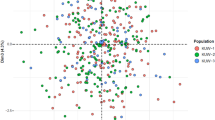Abstract
Allele frequency distribution and forensic parameters of the AmpFℓSTR Identifiler kit was determined in nine Mexican Amerindian populations based on 1,040 unrelated individuals from the pre-Columbian region known as Mesoamerica. Hardy-Weinberg equilibrium was demonstrated for most of the short tandem repeats (STRs) in all nine populations. The power of discrimination and exclusion were higher than 0.99999 and 0.997942, respectively. In addition, a brief overview of the genetic relatedness and structure (F st = 2.62 %; p = 0.00000) between these populations is presented.
Similar content being viewed by others
References
Rangel-Villalobos H, Martínez-Sevilla VM, Salazar-Flores J, Martínez-Cortez G, Muñoz-Valle JF et al (2013) Forensic parameters for 15 STRs in eight Amerindian populations from the north and west of Mexico. Forensic Sci Int Genet 7:e62–e65
Martínez-Cortés G, Nuño-Arana I, Rubi-Castellanos R, Vilchis-Dorantes G, Luna-Vázquez A et al (2010) Origin and genetic differentiation of three Native Mexican groups (Purépechas, Triquis and Mayas): contribution of CODIS-STRs to the history of human populations of Mesoamerica. Ann Hum Biol 37:801–819
Erosa-Solana E, Ruz MH, Robledo-Hernández G (1995) Etnografía contemporánea de los pueblos indígenas de México, Región Sureste. Instituto Nacional Indigenista (INI), México
Vargas-Alarcon G, Moscoso J, Martinez-Laso J, Rodriguez-Perez JM, Flores-Dominguez C et al (2007) Origin of Mexican Nahuas (Aztecs) according to HLA genes and their relationships with worldwide populations. Mol Immunol 44:747–755
Sánchez C, Barrot C, Ortega M, González-Martin A, Gorostiza A, Corbella J, Huguet E, Gené M (2005) Genetic diversity of 15 STRs in Choles from northeast of Chiapas (Mexico). J Forensic Sci 50:1499–1501
Barrot C, Sánchez C, Ortega M, González-Martín A, Brand-Casadevall C, Gorostiza A, Huguet E, Corbella J, Gené M (2005) Characterisation of three Amerindian populations from Hidalgo State (Mexico) by 15 STR-PCR polymorphisms. Int J Legal Med 119:111–115
Ibarra-Rivera L, Mirabal S, Regueiro MM, Herrera RJ (2008) Delineating genetic relationships among the Maya. Am J Phys Anthropol 135:329–347
Quinto-Cortés CD, Arriola LA, García-Hughes G, García-López R, Molina DP, Flores M, Palacios R, Piñero D (2010) Genetic characterization of indigenous peoples from Oaxaca, Mexico, and its relation to linguistic and geographic isolation. Hum Biol 82:409–432
Excoffier L, Lischer H (2010) An integrated software package for population genetics data analysis. University of Berne, Switzerland
Poetsch M, Bajanowski T, Pfeiffer H (2012) The publication of population genetic data in the International Journal of Legal Medicine: guidelines. Int J Legal Med 126(4):489–490
Acknowledgments
This project received financial support from CONACyT (grant 129693) to H R-V, and the fellowship to CD M-R.
Conflict of interest
The authors declare no conflict of interest.
Author information
Authors and Affiliations
Corresponding author
Additional information
H. Rangel-Villalobos and C. D. Muñoz-Rivas contributed equally to this work.
Electronic supplementary material
Below is the link to the electronic supplementary material.
Fig. S1
MDS plot representing the genetic distances (FST) between the nine Mexican Native populations analyzed herein. Meaning of the label after the name of the populations: (M) Mayan-related language; (N) Nahua-related language; (YP) Yucatan Peninsula. (JPEG 17 kb)
Table S1
(DOC 34 kb)
Table S2
(DOC 115 kb)
Table S3
(DOC 101 kb)
Table S4
(DOC 105 kb)
Table S5
(DOC 110 kb)
Table S6
(DOC 115 kb)
Table S7
(DOC 112 kb)
Table S8
(DOC 116 kb)
Table S9
(DOC 113 kb)
Table S10
(DOC 115 kb)
Table S11
(DOC 38 kb)
Rights and permissions
About this article
Cite this article
Rangel-Villalobos, H., Muñoz-Rivas, C.D., Martínez-Sevilla, V.M. et al. Forensic evaluation of the AmpFℓSTR Identifiler kit in nine Mexican native populations from the pre-Columbian Mesoamerican region. Int J Legal Med 128, 467–468 (2014). https://doi.org/10.1007/s00414-013-0956-y
Received:
Accepted:
Published:
Issue Date:
DOI: https://doi.org/10.1007/s00414-013-0956-y



